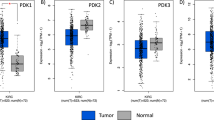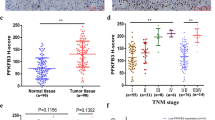Abstract
Purpose
Metabolic adaptations, such as increases in glucose and energy metabolism, play a pivotal role in the biology of RCC. PDK-1 and DJ-1/PARK7 are thought to control metabolic pathways in cancer. We investigated the expression of PDK-1 and DJ-1/PARK7 in RCC and their prognostic relevance.
Methods
RCC tumor tissue and corresponding normal parenchyma samples were obtained from 91 patients with clear cell RCC. Expression of PDK-1 and DJ-1/PARK7 was determined on the mRNA and protein levels using quantitative RT-PCR and immunohistochemistry. Expression ratios tumor/normal were analyzed for associations with pathological stage and grade (Kruskal–Wallis ANOVA, chi-square test). Potential associations with progression-free and overall survival were analyzed using Cox regression models.
Results
PDK-1 mRNA expression was up-regulated as compared to normal tissue (p < 0.001). Differences were observed by tumor stage (p < 0.05) with a trend toward lower expression with increasing stage (p > 0.01). Expression ratio tumor/normal also showed differences by tumor stage with the lowest ratio observed in advanced (pT3) disease. MRNA expression data were confirmed on the protein level with the lowest protein expression in pT3 tumors. PDK-1 expression ratio tumor/normal was inversely associated with outcome after adjustment for stage and grade (HR, 0.54; 95 % CI, 0.31–0.94). No associations observed for DJ-1/PARK7 expression.
Conclusions
PDK is up-regulated in RCC, but down-regulation may be associated with progression toward a metastasizing behavior. Given the role of PDK-1 in the control of glucose metabolism, aerobic glycolysis via up-regulation of PDK-1 may be an early event in RCC development, but less relevant for the progression toward an aggressive phenotype.



Similar content being viewed by others
References
Catchpole G, Platzer A, Weikert C, Kempkensteffen C, Johannsen M, Krause H, Jung K, Miller K, Willmitzer L, Selbig J, Weikert S (2011) Metabolic profiling reveals key metabolic features of renal cell carcinoma. J Cell Mol Med 15(1):109–118. doi:10.1111/j.1582-4934.2009.00939.x
Garber K (2006) Energy deregulation: licensing tumors to grow. Science 312(5777):1158–1159. doi:10.1126/science.312.5777.1158
McFate T, Mohyeldin A, Lu H, Thakar J, Henriques J, Halim ND, Wu H, Schell MJ, Tsang TM, Teahan O, Zhou S, Califano JA, Jeoung NH, Harris RA, Verma A (2008) Pyruvate dehydrogenase complex activity controls metabolic and malignant phenotype in cancer cells. J Biol Chem 283(33):22700–22708. doi:10.1074/jbc.M801765200
Korotchkina LG, Patel MS (2001) Site specificity of four pyruvate dehydrogenase kinase isoenzymes toward the three phosphorylation sites of human pyruvate dehydrogenase. J Biol Chem 276(40):37223–37229. doi:10.1074/jbc.M103069200
Dang CV (2007) The interplay between MYC and HIF in the Warburg effect. Ernst Schering Found Symp Proc 4:35–53
Kim JW, Gao P, Liu YC, Semenza GL, Dang CV (2007) Hypoxia-inducible factor 1 and dysregulated c-Myc cooperatively induce vascular endothelial growth factor and metabolic switches hexokinase 2 and pyruvate dehydrogenase kinase 1. Mol Cell Biol 27(21):7381–7393. doi:10.1128/MCB.00440-07
Papandreou I, Cairns RA, Fontana L, Lim AL, Denko NC (2006) HIF-1 mediates adaptation to hypoxia by actively downregulating mitochondrial oxygen consumption. Cell Metab 3(3):187–197. doi:10.1016/j.cmet.2006.01.012
Marcondes AM, Li X, Gooley TA, Milless B, Deeg HJ (2010) Identification of DJ-1/PARK-7 as a determinant of stroma-dependent and TNF-alpha-induced apoptosis in MDS using mass spectrometry and phosphopeptide analysis. Blood 115(10):1993–2002. doi:10.1182/blood-2009-08-236992
Vasseur S, Afzal S, Tardivel-Lacombe J, Park DS, Iovanna JL, Mak TW (2009) DJ-1/PARK7 is an important mediator of hypoxia-induced cellular responses. Proc Natl Acad Sci USA 106(4):1111–1116. doi:10.1073/pnas.0812745106
Sitaram RT, Cairney CJ, Grabowski P, Keith WN, Hallberg B, Ljungberg B, Roos G (2009) The PTEN regulator DJ-1 is associated with hTERT expression in clear cell renal cell carcinoma. Int J Cancer 125(4):783–790. doi:10.1002/ijc.24335
Kononen J, Bubendorf L, Kallioniemi A, Barlund M, Schraml P, Leighton S, Torhorst J, Mihatsch MJ, Sauter G, Kallioniemi OP (1998) Tissue microarrays for high-throughput molecular profiling of tumor specimens. Nat Med 4(7):844–847
Schraml P, Kononen J, Bubendorf L, Moch H, Bissig H, Nocito A, Mihatsch MJ, Kallioniemi OP, Sauter G (1999) Tissue microarrays for gene amplification surveys in many different tumor types. Clin Cancer Res 5(8):1966–1975
Mirlacher M, Kasper M, Storz M, Knecht Y, Durmuller U, Simon R, Mihatsch MJ, Sauter G (2004) Influence of slide aging on results of translational research studies using immunohistochemistry. Mod Pathol 17(11):1414–1420. doi:10.1038/modpathol.3800208
Jung M, Ramankulov A, Roigas J, Johannsen M, Ringsdorf M, Kristiansen G, Jung K (2007) In search of suitable reference genes for gene expression studies of human renal cell carcinoma by real-time PCR. BMC Mol Biol 8:47. doi:10.1186/1471-2199-8-47
Merino MJ, Valera VA (2011) Misdiagnosis of clear cell renal cell carcinoma. Nat Rev Urol 8(6):321–333. doi:10.1038/nrurol.2011.64
Wigfield SM, Winter SC, Giatromanolaki A, Taylor J, Koukourakis ML, Harris AL (2008) PDK-1 regulates lactate production in hypoxia and is associated with poor prognosis in head and neck squamous cancer. Br J Cancer 98(12):1975–1984. doi:10.1038/sj.bjc.6604356
Koukourakis MI, Giatromanolaki A, Sivridis E, Gatter KC, Harris AL (2005) Pyruvate dehydrogenase and pyruvate dehydrogenase kinase expression in non small cell lung cancer and tumor-associated stroma. Neoplasia 7(1):1–6
Koukourakis MI, Giatromanolaki A, Bougioukas G, Sivridis E (2007) Lung cancer: a comparative study of metabolism related protein expression in cancer cells and tumor associated stroma. Cancer Biol Ther 6(9):1476–1479
Pan JG, Mak TW (2007) Metabolic targeting as an anticancer strategy: dawn of a new era? Sci STKE 2007(381):pe14. doi:10.1126/stke.3812007pe14
Michelakis ED, Webster L, Mackey JR (2008) Dichloroacetate (DCA) as a potential metabolic-targeting therapy for cancer. Br J Cancer 99(7):989–994. doi:10.1038/sj.bjc.6604554
Cairns RA, Papandreou I, Sutphin PD, Denko NC (2007) Metabolic targeting of hypoxia and HIF1 in solid tumors can enhance cytotoxic chemotherapy. Proc Natl Acad Sci USA 104(22):9445–9450. doi:10.1073/pnas.0611662104
Bonnet S, Archer SL, Allalunis-Turner J, Haromy A, Beaulieu C, Thompson R, Lee CT, Lopaschuk GD, Puttagunta L, Harry G, Hashimoto K, Porter CJ, Andrade MA, Thebaud B, Michelakis ED (2007) A mitochondria-K+ channel axis is suppressed in cancer and its normalization promotes apoptosis and inhibits cancer growth. Cancer Cell 11(1):37–51. doi:10.1016/j.ccr.2006.10.020
Sun RC, Fadia M, Dahlstrom JE, Parish CR, Board PG, Blackburn AC (2010) Reversal of the glycolytic phenotype by dichloroacetate inhibits metastatic breast cancer cell growth in vitro and in vivo. Breast Cancer Res Treat 120(1):253–260. doi:10.1007/s10549-009-0435-9
Pathania D, Millard M, Neamati N (2009) Opportunities in discovery and delivery of anticancer drugs targeting mitochondria and cancer cell metabolism. Adv Drug Deliv Rev 61(14):1250–1275. doi:10.1016/j.addr.2009.05.010
Acknowledgments
We thank Waltraud Jekabsons and Antonia Maas for technical assistance with the experiments.
Conflict of interest
The authors declare that they have no conflict of interest.
Author information
Authors and Affiliations
Corresponding author
Rights and permissions
About this article
Cite this article
Baumunk, D., Reichelt, U., Hildebrandt, J. et al. Expression parameters of the metabolic pathway genes pyruvate dehydrogenase kinase-1 (PDK-1) and DJ-1/PARK7 in renal cell carcinoma (RCC). World J Urol 31, 1191–1196 (2013). https://doi.org/10.1007/s00345-012-0874-5
Received:
Accepted:
Published:
Issue Date:
DOI: https://doi.org/10.1007/s00345-012-0874-5




